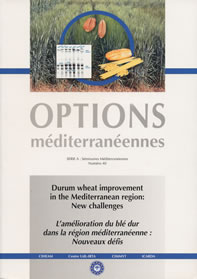| Article précédent | p. 413-416 | Article suivant |
Variability for resistance to cereal cyst nematodes in Triticeae: Potential use for Triticum turgidum L. var. durum improvement
Rivoal R., Bel Hadj Fradj M., Valette S., Mokabli A., Jahier J., Zaharieva M., Nicol J.M.
Eleven populations of Heterodera avenae originating from six circum-mediterranean countries (Algeria, France, Israel, Morocco, Spain, Syria) and one population of Heterodera latipons (Syria) have been studied for their development capability (virulence) on different Triticeae. Several of these plant genotypes are known to carry resistance genes. The host reactions of Aegilops geniculata populations sourced from different locations in the Mediterranean area were also investigated. Results are presented on resistance levels of these genetic resources which differ according to the fitness and the virulence spectrum of the nematode populations tested.
- [ Afficher ]
- [ Télécharger ]
- [ Exporter la citation ]
Vous pouvez télécharger la citation au format :
- [ Imprimer ]
-
Mots-clés
NEMATODE DES PLANTES, POUVOIR PATHOGENE, RESISTANCE AUX ORGANISMES NUISIBLES, TRITICUM TURGIDUMCiter cet article
Rivoal R., Bel Hadj Fradj M., Valette S., Mokabli A., Jahier J., Zaharieva M., Nicol J.M. Variability for resistance to cereal cyst nematodes in Triticeae: Potential use for Triticum turgidum L. var. durum improvement. In : Royo C. (ed.), Nachit M. (ed.), Di Fonzo N. (ed.), Araus J.L. (ed.). Durum wheat improvement in the Mediterranean region: New challenges . Zaragoza : CIHEAM, 2000. p. 413-416. (Options Méditerranéennes : Série A. Séminaires Méditerranéens; n. 40). Seminar on Durum Wheat Improvement in the Mediterranean Region: New Challenges, 2000/04/12-14, Zaragoza (Spain). http://om.ciheam.org/om/pdf/a40/00600068.pdf



